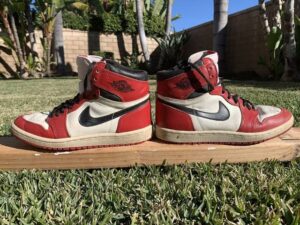The sneaker game has always been deeply intertwined with Black culture, shaping and reflecting the community’s unique style, identity, and social movements. Over the years, several iconic sneakers have transcended mere fashion to become symbols of cultural expression, empowerment, and even resistance. Here are five sneakers that significantly changed the game for Black people:
1. Air Jordan 1 (1985)
The Air Jordan 1, designed by Peter Moore, marked the beginning of Michael Jordan’s legendary partnership with Nike. This sneaker wasn’t just a product; it was a cultural revolution. When the NBA banned Jordan from wearing the black and red colorway due to uniform regulations, Nike turned the incident into a marketing masterstroke, framing the sneaker as a symbol of rebellion. The Air Jordan 1 became more than just a basketball shoe—it became a statement of individuality and resistance. For many Black youth, it was a status symbol and a source of pride, making it a must-have in their wardrobe.
2. Adidas Superstar (1969)
Before the rise of basketball-centric sneakers, the Adidas Superstar was already making waves. Popularized by the legendary hip-hop group Run-D.M.C., the Superstar became a symbol of street culture in the 1980s. The group’s iconic look—pairing Superstars with tracksuits and no laces—redefined fashion and helped cement the connection between hip-hop and sneaker culture. This shoe wasn’t just a fashion statement; it was a part of a movement that highlighted Black creativity and influence on global culture.
3. Nike Air Force 1 (1982)
The Nike Air Force 1, designed by Bruce Kilgore, started as a basketball shoe but quickly became a streetwear staple. Its simple, versatile design made it a blank canvas for self-expression. Over time, the AF1 has become synonymous with Black culture, particularly in cities like New York and Baltimore, where it earned the nickname “Uptowns.” The Air Force 1 is more than just a shoe; it’s a cultural artifact, representing the blend of sport, music, and fashion that defines urban Black culture.
4. Converse Chuck Taylor All Star (1970s)
While the Converse Chuck Taylor All Star predates the modern sneaker era, its impact on Black culture is undeniable. Originally a basketball shoe, it became a symbol of counterculture and self-expression. In the 1970s and ’80s, Chucks were embraced by Black musicians, artists, and activists as a symbol of rebellion and individuality. Their timeless design and affordable price made them accessible to everyone, turning them into a staple of Black street style across generations.
5. Reebok Classic Leather (1983)
The Reebok Classic Leather emerged as a running shoe but quickly gained popularity on the streets. In the late 1980s and 1990s, the shoe became a favorite in Black communities, known for its clean design and comfort. It was especially popular in the hip-hop scene, where it was often paired with tracksuits and oversized clothing. The Reebok Classic Leather represented a new level of sophistication and style, and its influence can still be seen in today’s sneaker culture.
Conclusion
These five sneakers are more than just footwear—they’re cultural symbols that have played a significant role in shaping the identity and expression of Black communities. From the rebellious spirit of the Air Jordan 1 to the street-savvy style of the Nike Air Force 1, these shoes have left an indelible mark on both sneaker culture and Black history. They remind us that sneakers are not just about fashion—they’re about identity, empowerment, and the ability to make a statement without saying a word.




